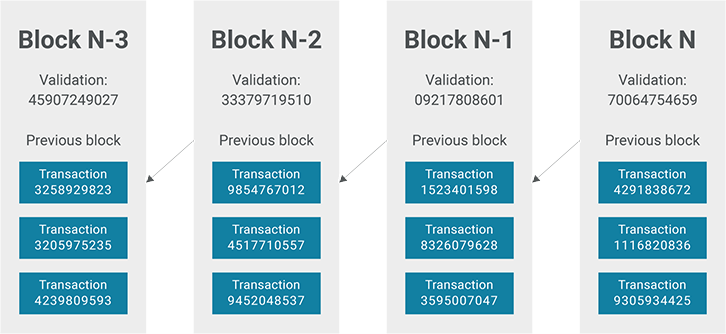Everyone’s heard of blockchain technology. In just about every industry, claims are made about how blockchains can revolutionize, disrupt, streamline, or otherwise improve the state of the art. Although finance has been the first area of notoriety, there’s a lot of talk—and in some cases action—about applying blockchain technology to the media industry. Here I’ll discuss the types of applications that are being investigated for blockchain technology in publishing, and I’ll compare them to blockchain developments in other media industry segments such as music and visual arts.
First, for those who aren’t familiar with the basics of blockchain technology, a blockchain is a type of distributed database—a ledger of transactions that isn’t owned by any single entity. Instead, every entity that participates in a blockchain has a copy of it that is guaranteed to be complete at any given time.
It’s only possible to add transactions to a blockchain; once there, they can’t be altered or removed. When a process wants to add data to a blockchain, it constructs a block of data and appends it to the blockchain with a link. Then a protocol runs to validate the data in the new block. This typically involves other entities performing complex mathematical and cryptographic calculations on the data to validate it. The data is considered valid once a sufficient number of entities has agreed on its validity as a result of those calculations; details vary from one scheme to another. The entities performing the validation need sufficient incentives to do it correctly.

Just as there can be an infinite number of databases, there can be many blockchains. Blockchains can be public or private, and entities that post data onto blockchains can be known or anonymous. It all depends on the requirements of the application. In the Bitcoin environment, entities called miners perform validation, a task that gets harder (requires more computing power) as the chain gets bigger. Miners are rewarded for validating transactions by being paid in Bitcoin.
Blockchain and the Publishing Industry
There are three general types of blockchain applications in publishing: rights licensing and royalty processing, print supply chain management and piracy tracking, and e-book ownership transfers.
The type of application that’s showing the most practical promise in media these days is rights licensing and royalty processing. The music industry is leading the way in this area, followed by image licensing.
In publishing, various organizations exist to license rights and process royalty transactions. A prominent example is Copyright Clearance Center’s RightsLink platform, which works with various websites and other services to automate those processes. The simplest way to consider blockchain’s applicability here is to think of it as a decentralized, ownerless version of a rights clearinghouse. If you’re a content licensee, such as an aggregator, foreign distributor, or other publisher (e.g., an educational publisher licensing an equation or illustration for use in a textbook), you could license some content and deposit a transaction on a blockchain. The owner of rights in that content can read that transaction and kick off additional transactions to obtain consideration from you, such as a royalty payment or permission letter.

Disclaimer: This is to inform readers that the views, thoughts, and opinions expressed in the article belong solely to the author, and do not reflect the views of Amnet.
Copyright © 2020 Amnet. All rights reserved. No part of this publication may be reproduced, distributed, or transmitted in any form or by any means, including photocopying, recording, or other electronic or mechanical methods, without the prior written permission of the publisher, except in the case of brief quotations embodied in critical reviews and certain other non-commercial uses permitted by copyright law. For permission requests, write to John Purcell, Executive Editor- Amnet, addressed “Attention: Permissions” and email it to: [email protected]
